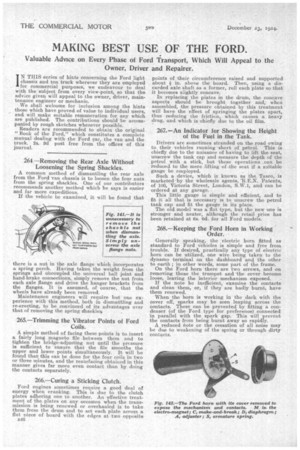MAKING BEST USE OF THE FORD.
Page 30

If you've noticed an error in this article please click here to report it so we can fix it.
Valuable Advice on Every Phase of Ford Transport, Which Will Appeal to the Owner, Driver and Repairer.
IN THIS series of hints concerning the Ford light chassis and ton truck wherever they are employed for commercial purposes, we endeavour to deal with the subject from every view-point, so that the advice given will appeal to the owner, driver, maintenance engineer or mechanic.
We shall welcome for inclusion among the hints those which have proved of value to individual users, and will make suitable remuneration for any which are published. The contributions should he accompanied by rough sketches wherever possible. Readers are recommended to obtain the original "Book of the Ford," which constitutes a complete manual dealing with the Ford gar, the van and the truck. 2s. 9d past free from the offices of this journal.
2-64 —Removing the Rear Axle Without Loosening the Spring Shackles.
A common method of dismantling the rear axle from the Ford van chassis is to loosen the four nuts from the spring shackles. One of our contributors recommends another method which he says is easier and far more expeditious.
If the vehicle be examined, it will be found that
there is a nut in the axle flange which incorporates a spring perch. Having taken the weight from the springs and nhcoupled the universal ball joint and hand-brake connections, simply remove the nut from each axle flange and drive the hanger brackets from the flanges. It is assumed, of course, that the wheels have already been removed. Maintenance engineers will require but one experience with this method, both in dismantling and re-erecting, to be convinced of its advantages over that of removing the spring hacklea
265.—Trimming the Vibrator Points of Ford Coils.
A simple method of facing these points is to-insert a fairly long magneto file between them and to tighten the bridge-adjusting nut until the pressure is sufficient to ensure that the file smooths the upper and lower points simultaneously. It will be found that this can be done for the four coils in two or three minutes, and the resurfacing obtained in this manner gives far more even contact than by doing the contacts separately.
266.—Curing a Sticking Clutch.
Ford engines sometimes require a good deal of energy when cranking. This is due to the clutch plates adhering one to another. An effective treatment of the plates on any occasion when the transmission is being renewed or overhauled is to take them from the drum and to set each plate across a flat piece of board with the edges at two opposite B46 points of their circumference raised andsupported
about in. above the board. Then, using a discarded axle shaft as a former, roll each Plate so that it becomes slightly concave.
In replacing the plates in the drum, the concave aspects should be brought together and, when assembled, the pressure obtained by this treatment will have the effect of springing the plates apart, thus reducing the friction, which causes a heavy drag, and which is chiefly due to the oil film.
267.—An Indicator for Showing the Height of the Fuel in the Tank.
Drivers are sometimes stranded on the road owing to their vehicles running short of petrol. This is chiefly due to the nuisance of having to lift the. seat, unscrew the tank cap and measure the depth of the petrol with a stick, but these operations .can be reduced to the mere lifting of -the seat if a suitable gauge be employed. Such a device, which is known as the Disco, is marketed by the wholesale agents, B.E.N. Patents, of 100, Victoria Street, London, S.W.1, and can be ordered at any garage.
This little gauge is simple and efficient, and to fit it all that is necessary is to unscrew the petrol tank cap and fit the gauge in its place. The old model was a flat type, but the new one is stronger and neater, although the retail price has been retained at 6s. 6d. for all Ford models.
268.—Keeping the Ford Horn in Working Order.
Generally speaking, the electric horn fitted as standard to Ford vehicles is simple and free from trouble. If desired, practically any type of electric horn can be utilized, one wire being taken to the dynamo terminal on the dashboard and the other to earth ; in other words, some part of the frame. On the Ford horn 'there are two screws, and on removing these the trumpet and the cover become
loose' leaving the interior mechanism exposed. -.If the note be inefficient, examine the contacts
and clean them, or, if they are badly burnt, have them renewed.
When the horn is working in the dark with the cover off, sparks may be seen leaping across the contacts. These can be prevented by fitting a condenser (of the Ford type for preference) connected in parallel with the spark gap. This will prevent the contacts from being burnt away so rapidly. A reduced tote or the cessation of all noise may be due to weakening of the spring or through dirty contacts.
































